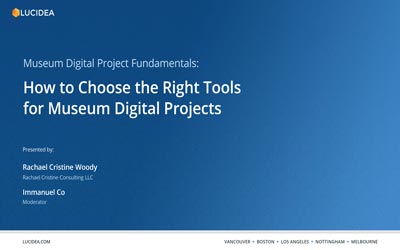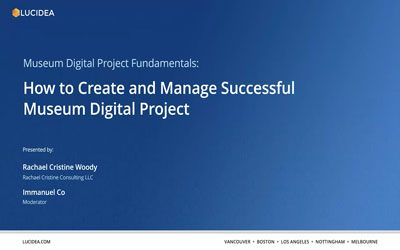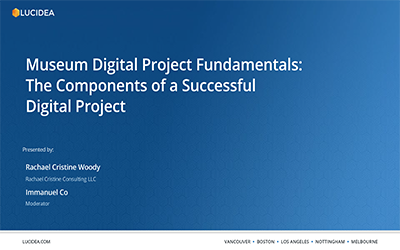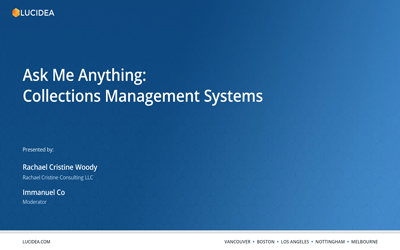Storytelling Goals with Collections Online
Read Transcription
Before we start, I would like to provide some information about our company and introduce today’s presenter. Lucidea is a software developing company specialized in museum and archival collections management solutions, as well as knowledge management and library automation systems. Our brands include Sydney, Presto, Argus, ArchivEra, Eloquent, and CuadraSTAR.
Now I would like to take a moment to introduce today’s presenter, Rachel Christine Woody. Rachel is the owner of Relicura and provides services to museums, libraries, and archives. She specializes in museum collections management systems, digitization technology, digital project management, and digital usership. During the course of her career, she has successfully launched multiple digital projects that include advanced digitization technology, collaborative portals, and the migration of collection information into collections management systems. She’s also a popular guest author for Blue City’s Think Clearly blog and has provided us with many great webinars that are listed on our website. So please feel free to check us out after today’s session. Take it away, Rachel.
Great. Thank you so much, Bradley. Thank you to Lucidio for hosting us today, and thank you for attending today’s session.
We will be covering digital storytelling and getting into some of the foundational aspects of storytelling and how that can integrate into a digital storytelling platform.
In terms of the, foundational elements, we’ll talk about storytelling goals today.
The storytelling goals are three primary ones, the first of which is engagement, the second of which is learning, and the third of which is reflection. And then we’ll do a little wrap up once we’ve covered those.
So for our introduction to storytelling goals, regardless of platform, regardless of even type of story, when we’re thinking of storytelling, we are thinking of what we wish to impart in telling that story. So stories, yes, can be entertaining and and contain a multitude of emotions, help pass the time, but they also help pass information.
And so when we are in our museum mode and telling stories either through physical exhibitions or through a new digital storytelling platform, Regardless of format and regardless of entertainment factor or emotions conveyed, there’s still those three principal goals in mind. So when we tell stories, we want to make sure that we are providing points of engagement for people, and we’ll get into some more detail about what points of engagement mean and what they can look like. We also want to make sure we’re imparting some sort of learning, whether that is, you know, back when we were children and we were learning morals and learning safety and values in our stories. The same is true as adults.
Doing a story is often to convey some sort of learning in addition to that entertainment that we get from it.
And then of course the third goal of storytelling in any of its forms is to help inspire reflection and to offer us opportunities as humans and as individuals to do that sort of introspection of stories we have heard or have witnessed and how that may apply to our own lives and how we choose to live them that kind of thing. So again sort of regardless of story type regardless of your age, storytelling in any of its forms will always have these three goals.
Getting into that first one engagement The engagement process again regardless of how the story is told or what story is tends to happen in three phases.
So the first of which is that primary capture of attention. So when we are crafting our stories when we are conveying them to other individuals, we want to make sure that we are paying attention to how we are doing that capture of attention.
There are multiple different story methods and tips and tricks for how to actually do that engagement factor for capturing of attention, but ultimately, it is how you first get the person hooked. So whether it’s a mysterious opening of a story, whether it’s sort of like a initial shock or surprise of an opening of a story, However you choose to open it, it needs to have some sort of hook that further invites people in to pay attention to it.
Second phase of engagement is, presenting the story and information that will help to trigger a sympathy or empathy reaction.
Sympathy is when we can see a portion of the story and it’s something that we recognize as having experienced or felt ourselves, in which case we can see ourselves in that position and can sympathize with it or empathize where we may not have been in a particular situation or have experienced that particular thing that we are seeing in the story.
However, we can still relate to that human, how the human may be feeling, we can very much empathize with that person or with what’s happening in that story.
Regardless of whether it is sympathy or empathy, both will help work to further create that engagement with ourselves. So first one, attention capture for our brains.
Second one is in a way an attention capture for our hearts.
The third phase is giving them some sort of motivation and drive to see the story through to the end. So you’ve got our attention, we can very much see either see ourselves or empathize with people in the story and what is happening, and now we have some sort of motivation to see it through to the end. So at this point, for this third phase of engagement, the story needs to be interesting and compelling enough and to have, a good enough timing, so not too long or not too short, where we have this motivation to see the story through to the end.
With these three phases, if you are able to engage each one, then you can very successfully see people through regardless of age through each of those pieces of engagement.
As we think about engagement mechanisms, there are two sort of lenses we’ll use one of which is putting it into a museum setting and thinking about exhibitions in a hybrid format. So hybrid being there’s this in person exhibition very traditional but or and you are also offering a online experience to help sort of supplement that exhibition And for us, exhibition is very much the telling of a story.
The second lens we’ll use in just a few moments as if it is a completely online exhibition experience.
Both formats, whether hybrid or online completely, offer the same sort of storytelling arc and have the same sort of storytelling goals, and we can think of mechanisms for each. They’re just going to vary a little bit in execution.
So for us with engagement for the hybrid mode of in person with online supplement, we can start doing that interconnection of engagement by using either QR codes which are big right now or some sort of mechanism to provide a link to the online exhibit as it relates to where that person is in the in person exhibit. So offering supplemental materials, offering additional information.
I’ve seen museums use this really well to help provide reflection type questions, or ability to sort of, like, choose your own adventure, choose your own pathway through an exhibition by offering it in this hybrid format.
Another thing that you can do to help with that up another point of engagement is offering audio visual supplemental material to the more traditional either artifact or artwork type, in person physicality of an exhibition, offering additional modalities of information that help to engage more than just like a visual sense.
So having a sense of different artifacts, different ways of engagement, different types of items will help increase that engagement factor.
And when we are pairing that with online exhibit, it makes it even as even easier to include audio visual materials.
Another point of engagement for us is multi vocal, which is basically multi perspective storytelling.
In physical exhibitions it can be difficult to try and introduce and maintain multiple different perspectives or storylines to to our loss in that regard but if we’re doing a hybrid exhibition we can offer those additional perspectives those additional interactions and points of view in a particular narrative with an online component. So no longer is space a restriction it is more in how you can engage different tools such as the online exhibit to help with that engagement factor.
And then online gallery of related items as human beings we are naturally curious and if there are things we are interested in and if it is easy enough to do we will happily go down rabbit holes of things that we find interesting.
The key here is to make it easy and obvious, and so when we’re thinking about exhibition narratives, we’re in a hybrid environment, we want to make sure that the online component makes it incredibly easy to invite people into our online collections for further discovery.
Now thinking through and using that secondary lens, if we were doing an exhibition entirely online, we are able to engage in a little bit of different ways.
Thinking about the links, we are entirely online which offers the interlinking of content and different narratives, in a different way. And so as long as the mapping is solid, which can take a bit to sort of, get that all navigated and laid out, there can be some tremendous interlinking and even, like self determinant pathway discovery when we’re presenting a narrative online.
Those audio visual elements super important so we incorporated them in that first lens and important to incorporate when we’re in this online exhibition environment as well whether that is introducing it and displaying it as one of the items depending on if you’re doing like a CMS sort of deployment of your story or if you are using a storytelling platform, being able to offer these audio visual supplements to what the person is either reading or seeing will help engage more senses and help engage that person.
And that multi vocal, multi perspective storytelling, it can be even easier to deploy in an entirely online exhibition platform and having those multiple pathways can help you further execute those different perspectives. So for example each sort of pathway through a particular exhibition story there can be a perspective per pathway for example so in many ways it is often easier to deploy these mechanisms of engagement when you’re in an entirely online setting so something to consider as you think about exhibitions and whether there’s online components and certainly as you explore an online only exhibit.
All right, goal number two is learning and so for us when we’re thinking about storytelling through our exhibitions, first part’s engagement because if engagement doesn’t happen then the learning and reflection won’t happen after it. But learning is perhaps one of the weightier things for us to consider, especially since we have that additional challenge of serving a diverse amount of people in terms of different ages, different socioeconomic backgrounds, different points of references.
So having to sort of supply and offer a spectrum of information depending on who is engaging with and learning from the story that we’re telling.
So for us, keeping in mind the complexity of the audience we’re trying to provide for, the first and foremost most important thing is to provide an introduction and grounding of the topic.
This is particularly important for us to remember because we are often subject matter experts and or we’ve been living and breathing this exhibition story for months, if not a couple of years, and we can easily take for granted things that have become just such common knowledge for us, but is a completely new topic or new area of learning for most of our audience.
So we really need to pay attention and spend time on grounding the topic for our audience.
Next point is context.
Context helps human beings understand what is being presented to them and perhaps more importantly why, and it helps them to connect themselves to the story. So context will help aid in that sympathy empathy generation which is necessary for engagement and part of learning that can be imparted can happen once that person has an understanding of that context.
Next point of importance information offered on a sliding scale.
This is to help accommodate for the different ages and different learnings of the humans that come into contact with our storytelling and needing to offer it to a, perhaps younger visitor, someone who’s newer to the topic, all the way to helping provide additional supplemental information for people who want to dive further into that topic, who want to understand perhaps more of the complexities to that particular topic or aspect of the story. So offering a scale or spectrum of points of engagement for these points of learning will help to cater to our different visitors.
Another point demonstration of the concept this is so important especially for people where the topic or aspect of the story is new or like foreign they’ve never experienced it before.
Seeing a demonstration of that or an example of how the concept or topic is playing out can help sort of solidify that understanding and that learning.
And then finally summarization to help cement that learning, especially if it’s a newer learning for people.
Helping to, at the end, summarize what we’ve learned, what we’ve covered can help provide a very nice, like, end, like, can’t think of the word, but, like, capstone to the path that we’ve gone through, the lessons that we’ve taken along the way, and having it presented in that nice, like, one stop summary of what we’ve gone through together can very much help complete that learning pathway in our brains.
Okay. Goal number three is reflection. So we need engagement to get anywhere.
Engagement leads to learning, which is then critical for us to have to help inspire our own reflection.
So having points within the story that we’re telling within a particular exhibit can have different places or opportunities to help trigger that self reflection.
The first that tends to come up is in as you are telling the story any sort of first conflict first challenge first point of adversity in the particular story that is being told through the exhibition can help connect people and offer a point of reflection, sometimes as basic as what would I do if this particular conflict or challenge has come up or I now see the the person of this story has chosen this path like would I have chosen that would I have done something differently?
Offering different types of reflections and again whether there’s that empathy or sympathy generation to help with how we would put ourselves in that story and reflecting on those decisions.
Next point, actions or decisions with impact. So as the story progresses, if there are particular decisions that had to be made or that need to be made depending on aspect of the story you were telling and what the impact of those are and even if it is a particular action where there’s only speculation there can be speculation of that particular impact so having those having consequences and understanding consequences of those decisions or actions offers another, tremendous point of reflection for your visitors.
Next, the penultimate action, decision, or event. So this is like the, not quite the the top peak challenge or, like, the the last challenge. It is the one that leads up to that particular point. And in some respects and depending on the story you’re telling, the penultimate action, decision, or event is, in my opinion, as a storyteller, the actual most important part, not the peak event or the peak challenge of that particular story. Because without that penultimate action, decision, or event, you will have never actually made it to that other ultimate decision, action, or event.
So the the consequences of what happens at that penultimate point is arguably more impactful.
And then of course final challenge issue or event as we start to conclude the story it offers a nice closure piece to reflection of how we may have acted in that particular story line, how we found our protagonists and antagonists, how they acted, and a reflection of with the end of story and understanding of that where we are in relation to that story and where we are as a human in that story.
So with online storytelling, we get an added or increased degree of flexibility with how we execute that And when we’re thinking about reflection, the flexibility offer can be, really inspiring and also in some ways easier.
For example, flexibility and path making.
When you are going through a physical exhibition, there may be a couple different routes that you could physically take throughout.
However, there’s usually only one, two, at max, three different sort of routes you could take through that exhibit.
Exhibits also tend to not be, like, very prescriptive in how a user makes their way through. Whereas when presenting online, depending on the particular online platform you are using, you could provide an incredibly prescriptive and, like, there’s only one true pathway through a story.
However, the flexibility in offering, like, a potentially infinite number of pathways through can help in that degree of flexibility help with engagement learning and reflection aspects for each of our visitors and often the sort of information that we can get from that especially when we are doing online exhibit storytelling the statistics alone in terms of what visitors take in terms of pathway through our online presentation of the story can provide us some great even just basic information of what resonated the most with people what seemed to be the most popular pathways that people took through where were there different decision or inflection points for people in terms of whether they went left or right, for example, so So there can be a great amount derived from just a basic amount of information when you are presenting a story with multiple pathways online.
And then finally, being able to deliver appropriate prompts catered to the viewer can be so much easier and automated when presenting a story online so depending on the particular platform as the visitors make their way through in their particular pathway, they can be presented with points or prompts of reflection and in, in conjunction with the decisions that they made or reflected on in that particular story. So having the ability to not just sort of observe what is happening online with our visitors, but being able to react to it in an automated, but yet real time can offer some pretty powerful powerful points of reflection as well as just experience for those visitors experiencing that story online.
So for in our conclusion, we covered an introduction to storytelling goals and very much emphasized that it doesn’t matter how you are telling the story in terms of format or platform. It doesn’t matter what type of story you’re telling or even who you’re telling it to. There will always be these three primary goals to storytelling, and that’s the goal of engagement. And we cover different engagement mechanisms and how engagement is first and foremost the most important because if you have not engaged people, they will not learn or reflect.
We covered learning and the different, things to consider as we present information and present those learning opportunities to the broad aware of visitors that we can attract.
And then that reflection piece, which is such an important capstone to visitors going through our particular exhibitions, our stories that we are telling as it helps to cement not just new information learned, but cement that experience that the visitor had with us and our collection.
So with that, I’ll do a quick plug. Speaking of storytelling, this particular book is a story about data preparation and demystifying it as you enter either a new collections management system or if you are reaching a point in your existing CMS where you’d like to do some data preparation and cleanup. This particular book, in partnership with Lucidea, we are offering free e-copies. I encourage you to check it out.
And with that, I will turn it back over to Bradley.
Thank you, Rachael, for the wonderful presentation. And to our audience, if you’d like to learn more about our museum collections management system called Argus please feel free to visit our website or reach out to us at sales@lucidea.com and we’d be happy to have a chat with you.
And if you have any more questions on any of our software or our company our contact details are listed on the screen, and please stay tuned for more webinars and content related to this series.
On behalf of the Lucidea team, I thank you all for attending today, and until next time. Thank you.



